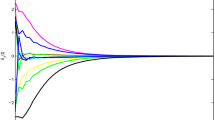Abstract
This paper introduced a new class of Complex Dynamic Networks (CDNs) with hybrid Time-Varying Delay (TVD) and Non-Time-Varying Delay (NTVD) nodes. Exponential Synchronization (ES) and Generalized Synchronization(GS) problems are studied by using a novel coupling Intermittent Periodically Adaptive Pinning Control (IPAPC) with these CDNs. Meanwhile, IPAPC has new characteristics with three switched intervals in every period. Based on IPAPC method, Kronecker product rules and Lyapunov Stability Theory (LST), necessary and sufficient conditions for ES and GS with IPAPC criteria of such CDNs have been deduced theoretically. Moreover, to verify the practicability and effectiveness of the proposed theoretical results and method, Nearest-Neighbor Network (NNN) and Barabási-Albert Network (BAN) consisting of coupled delay and non-delayed Lee chaotic attractor are finally given as the examples.
Similar content being viewed by others
References
E. N. Sanchez, D. I. Rodriguez-Castellanos, G. Chen, and R. Ruiz-Cruz, “Pinning control of complex network synchronization: a recurrent neural network approach,” International Journal of Control, Automation and Systems, vol. 15, pp. 1405–1414, Jun 2017.
H. Zhang and X. yuan Wang, “Cluster synchronization of boolean network,” Communications in Nonlinear Science and Numerical Simulation, vol. 55, pp. 157–165, 2018.
J. Lu and G. Chen, “A time-varying complex dynamical network model and its controlled synchronization criteria,” IEEE Transactions on Automatic Control, vol. 50, no. 6, pp. 841–846, 2005.
W. He and S. S. Ge, “Cooperative control of a nonuniform gantry crane with constrained tension,” Automatica, vol. 66, pp. 146–154, 2016.
R. Zhang, D. Zeng, J. H. Park, Y. Liu, and S. Zhong, “Nonfragile sampled-data synchronization for delayed complex dynamical networks with randomly occurring controller gain fluctuations,” IEEE Transactions on Systems, Man, and Cybernetics: Systems, vol. PP, no. 99, pp. 1–11, 2017.
M. Chadli and I. Zelinka, “Chaos synchronization of unknown inputs Takagi-Sugeno fuzzy: application to secure communications,” Computers & Mathematics with Applications, vol. 68, no. 12, Part A, pp. 2142–2147, 2014.
R. Zhang, D. Zeng, and S. Zhong, “Novel master-slave synchronization criteria of chaotic lur’e systems with time delays using sampled-data control,” Journal of the Franklin Institute, vol. 354, no. 12, pp. 4930–4954, 2017.
R. Zhang, X. Liu, D. Zeng, S. Zhong, and K. Shi, “A novel approach to stability and stabilization of fuzzy sampleddata markovian chaotic systems,” Fuzzy Sets and Systems, pp. In Press, Corrected Proof, 2017.
L. Pan, W. Zhou, L. Zhou, and K. Sun, “Chaos synchronization between two different fractional-order hyperchaotic systems,” Communications in Nonlinear Science and Numerical Simulation, vol. 16, no. 6, pp. 2628–2640, 2011.
L. Pan, L. Zhou, and D. Li, “Synchronization of threescroll unified chaotic system (tsucs) and its hyper-chaotic system using active pinning control,” Nonlinear Dynamics, vol. 73, pp. 2059–2071, Aug 2013.
Y. Tang, H. Gao, and J. Kurths, “Robust H ∞ self-triggered control of networked systems under packet dropouts,” IEEE Transactions on Cybernetics, vol. 46, pp. 3294–3305, Dec 2016.
Y. Tang, X. Xing, H. R. Karimi, L. Kocarev, and J. Kurths, “Tracking control of networked multi-agent systems under new characterizations of impulses and its applications in robotic systems,” IEEE Transactions on Industrial Electronics, vol. 63, pp. 1299–1307, Feb 2016.
C. K. Ahn, P. Shi, R. K. Agarwal, and J. Xu, “L¥ performance of single and interconnected neural networks with time-varying delay,” Information Sciences, vol. 346–347, no. Supplement C, pp. 412–423, 2016.
C. K. Ahn, L. Wu, and P. Shi, “Stochastic stability analysis for 2-d roesser systems with multiplicative noise,” Automatica, vol. 69, no. Supplement C, pp. 356–363, 2016.
W. Xia and J. Cao, “Pinning synchronization of delayed dynamical networks via periodically intermittent control,” Chaos: An Interdisciplinary Journal of Nonlinear Science, vol. 19, no. 1, p. 013120, 2009.
S. Cai, X. Li, Q. Jia, and Z. Liu, “Exponential cluster synchronization of hybrid-coupled impulsive delayed dynamical networks: average impulsive interval approach,” Nonlinear Dynamics, vol. 85, pp. 2405–2423, Sep 2016.
J. Mei, M. Jiang, X. Wang, J. Han, and S. Wang, “Finitetime synchronization of drive-response systems via periodically intermittent adaptive control,” Journal of the Franklin Institute, vol. 351, no. 5, pp. 2691–2710, 2014.
H.-L. Li, C. Hu, H. Jiang, Z. Teng, and Y.-L. Jiang, “Synchronization of fractional-order complex dynamical networks via periodically intermittent pinning control,” Chaos, Solitons & Fractals, vol. 103, pp. 357–363, 2017.
X. Lei, S. Cai, S. Jiang, and Z. Liu, “Adaptive outer synchronization between two complex delayed dynamical networks via aperiodically intermittent pinning control,” Neurocomputing, vol. 222, pp. 26–35, 2017.
J. Wang, “Synchronization of delayed complex dynamical network with hybrid-coupling via aperiodically intermittent pinning control,” Journal of the Franklin Institute, vol. 354, no. 4, pp. 1833–1855, 2017.
G. Chen, “Pinning control and synchronization on complex dynamical networks,” International Journal of Control, Automation and Systems, vol. 12, no. 2, pp. 221–230, 2014.
J. Mei, M. Jiang, Z. Wu, and X. Wang, “Periodically intermittent controlling for finite-time synchronization of complex dynamical networks,” Nonlinear Dynamics, vol. 79, pp. 295–305, Jan 2015.
Y. Liang and X. Wang, “Synchronization in complex networks with non-delay and delay couplings via intermittent control with two switched periods,” Physica A: Statistical Mechanics and its Applications, vol. 395, pp. 434–444, 2014.
N. Li and J. Cao, “Periodically intermittent control on robust exponential synchronization for switched interval coupled networks,” Neurocomputing, vol. 131, pp. 52–58, 2014.
H.-G. Chen, Y.-H. Wang, and L.-L. Zhang, “Adaptive control based on extended neural network for siso uncertain nonlinear systems,” International Journal of Control, Automation and Systems, vol. 16, pp. 27–38, Feb 2018.
W. He, Y. Chen, and Z. Yin, “Adaptive neural network control of an uncertain robot with full-state constraints,” IEEE Transactions on Cybernetics, vol. 46, pp. 620–629, March 2016.
W. He, Y. Dong, and C. Sun, “Adaptive neural impedance control of a robotic manipulator with input saturation,” IEEE Transactions on Systems, Man, and Cybernetics: Systems, vol. 46, pp. 334–344, March 2016.
W. He, Z. Yan, C. Sun, and Y. Chen, “Adaptive neural network control of a flapping wing micro aerial vehicle with disturbance observer,” IEEE Transactions on Cybernetics, vol. 47, pp. 3452–3465, Oct 2017.
A. Karami-Mollaee and H. Tirandaz, “Adaptive fuzzy fault tolerant control using dynamic sliding mode,” International Journal of Control, Automation and Systems, vol. 16, pp. 360–367, Feb 2018.
M. Chadli, I. Zelinka, and T. Youssef, “Unknown inputs observer design for fuzzy systems with application to chaotic system reconstruction,” Computers & Mathematics with Applications, vol. 66, no. 2, pp. 147–154, 2013.
I. Zelinka, M. Chadli, D. Davendra, R. Senkerik, and R. Jasek, “An investigation on evolutionary reconstruction of continuous chaotic systems,” Mathematical and Computer Modelling, vol. 57, no. 1, pp. 2–15, 2013.
Y. Wei, J. Qiu, P. Shi, and M. Chadli, “Fixed-order piecewise-affine output feedback controller for fuzzyaffine-model-based nonlinear systems with time-varying delay,” IEEE Transactions on Circuits and Systems I: Regular Papers, vol. 64, pp. 945–958, April 2017.
R. Albert and A.-L. Barabási, “Statistical mechanics of complex networks,” Reviews of modern physics, vol. 74, no. 1, p. 47, 2002.
S. Cai, Q. He, J. Hao, and Z. Liu, “Exponential synchronization of complex networks with nonidentical timedelayed dynamical nodes,” Physics Letters A, vol. 374, no. 25, pp. 2539–2550, 2010.
B. Pachpatte, “A note on gronwall-bellman inequality,” Journal of Mathematical Analysis and Applications, vol. 44, no. 3, pp. 758–762, 1973.
J. A. Graham, Kronecker Products and Matrix Calculus With Applications, Halsted Press, John Wiley and Sons, New York, 1981.
D. Q. Li, “A three-scroll chaotic attractor,” Physics Letters A, vol. 372, pp. 387–393, 2008.
L. Pan, W. Zhou, and J. Fang, “Dynamics analysis of a new simple chaotic attractor,” International Journal of Control, Automation and Systems, vol. 8, pp. 468–472, Apr 2010.
Author information
Authors and Affiliations
Corresponding author
Additional information
Recommended by Associate Editor M. Chadli under the direction of Editor Myo Taeg Lim. This work was supported by the Chinese Fundamental Research Funds for the Central Universities (No.20410763, 20410956), ESI Program of WHUT, China (No.35400766) and Research Programs of Singapore.
Lin Pan received the M.Sc. degree in Applied Mathematics from Wuhan University of Technology, Wuhan, China, in 2007 and the Ph.D. degree in Control engineering from the Donghua University, Shanghai, China, in 2010 (Sino-German joint Ph.D. FernUniversität in Hagen, Germany). From 2011 to 2012, he was a Post-Doctoral Trainee with King Saud University, Riyadh, Saudi Arabia. From 2013 to 2016, he was with SnT-Interdisciplinary Centre for Security, Reliability and Trust, University of Luxembourg, Luxembourg, as a Marie Curie Fellow and Senior Researcher. Since 2016, he is with School of Logistics Engineering, Wuhan University of Technology, Wuhan, China, as a Professor. His current research interests include Control of Large-Scale Port Wind Farms, Control of Shore-to-ship Power Supply System in Port, Control of Complex Dynamic Network System and Multi-Agent Systems.
Xin Tang is an Associate Professor at School of Logistics Engineering, Wuhan University of Technology, Wuhan. He holds a Ph.D. in Computer Science from the University François Rabelais (Tours, France). During 2013–2015, he was a Post–Doctoral Fellow at Mines Nantes Graduate School of Engineering. His interests revolve around discrete mathematics: combinatorial optimization, network design and multi-agent systems.
Yongping Pan received his Ph.D. in control theory and control engineering from the South China University of Technology, Guangzhou, China in 2011. From 2007 to 2008, he was a Control Engineer in Santak Electronic Co., Ltd., US Eaton Group, Shenzhen, China, and US Light Engineering Co., Ltd., Guangzhou. From 2011 to 2013, he was a Research Fellow of the School of Electrical and Electronic Engineering, Nanyang Technological University, Singapore. He is currently a Senior Research Fellow in the Department of Biomedical Engineering, National University of Singapore, Singapore. He has authored or co-authored more than 60 peer-reviewed academic papers, including over 40 in reputable journals. His research interests cover automatic control, computational intelligence, and intelligent robotics, where he is currently focusing on biomimetic adaptive and learning control with applications to exoskeleton robots. During the postgraduate period, he received several important honors and awards, including the Rockwell Automation Master Scholarship, the Postgraduate Academic Award, the Innovation Fund of Excellent Doctoral Dissertations, and the Excellent Graduate Student Award. He has been an Associate Editor or Editorial Board Member of several referred international journals. He also serves as a Reviewer for over 40 international journals.
Rights and permissions
About this article
Cite this article
Pan, L., Tang, X. & Pan, Y. Generalized and Exponential Synchronization for a Class of Novel Complex Dynamic Networks with Hybrid Time-varying Delay via IPAPC. Int. J. Control Autom. Syst. 16, 2501–2517 (2018). https://doi.org/10.1007/s12555-017-0771-1
Received:
Revised:
Accepted:
Published:
Issue Date:
DOI: https://doi.org/10.1007/s12555-017-0771-1




